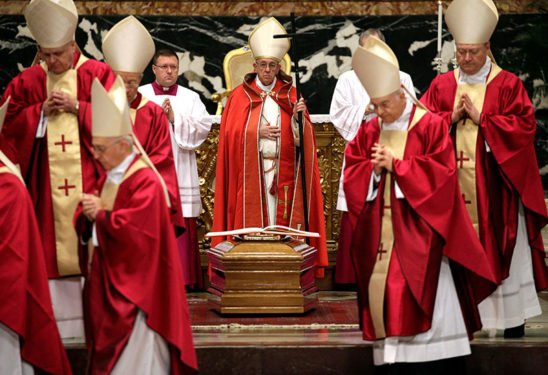
By Christopher White, National Correspondent
At a press conference on Wednesday, Cardinal Sean O’Malley was asked whether he believed Cardinal Bernard Law, his predecessor who became the public face of the Church’s child sexual abuse scandals, would be welcomed into heaven.
Cardinal Law died in Rome on Wednesday, Dec. 20, and is largely remembered for his damning cover-up of clergy sexual abuse.
Cardinal O’Malley told reporters that he hoped everyone would be welcomed into heaven – while also adding that he was not the one to judge. He also said that there was more to Cardinal Law than his mistakes – a means of acknowledging the obvious, while also pulling a page from Shakespeare in an effort to perhaps signal that discretion is the better part of valor.
While Cardinal Law’s death did not exactly elicit the sounds of silence that some had predicted, and indeed, some had even hoped for, it was by no means the usual fanfare that typically surrounds the death of a United States cardinal.
When Cardinal William Keeler, who led the Archdiocese of Baltimore from 1989 to 2007, died in March of this year, his death was met with an outpouring of tributes from fellow U.S. bishops. In the days following his death, Cardinal Keeler received a grand send-off with his reposed body given viewings at two locations, and Cardinal Timothy Dolan of New York served as homilist for the funeral Mass.
While Cardinal Law’s funeral was celebrated by Cardinal Angelo Sodano, the dean of the College of Cardinals, and attended by Pope Francis, it was arguably more of an exercise of protocol rather than an honorific celebration.
In a somewhat ironic outcome of history, the obituary in The New York Times for Cardinal Keeler – the most recent U.S. cardinal to pass away – was headlined “Cardinal Who Championed Sexual Abuse Victims, Dies at 86.” By contrast, Cardinal Law’s headline read “Powerful Cardinal Disgraced by Priest Abuse Scandal, Dies at 86.”
In a rare move on Wednesday, Cardinal Daniel DiNardo, president of the United States Conference of Catholic Bishops (USCCB), began his formal statement on the Cardinal’s death with a message for anyone that was aware of sexual abuse or a victim of it, to immediately report it to local law enforcement.
“As we reflect on the legacy of Cardinal Law, it will likely bring back painful memories for survivors. The Church seeks to always respond as supportive pastors,” said Cardinal DiNardo.
He went on to entrust Cardinal Law’s soul to Christ, echoing the statement from Cardinal O’Malley, and offered prayers for the “brave survivors of sexual abuse.”
Besides the official statements from the USCCB and the current Archbishop of Boston, the only other high profile statement to be released on Wednesday came from Bishop Christopher Coyne of Burlington, Vermont, who served as the principal spokesman for the Archdiocese of Boston in the immediate years after Cardinal Law’s sexual abuse cover-up came to light.
“Like each of us, the measure of his days had its fair share of light and shadows,” said Bishop Coyne. “While I knew him to be a man of faith, a kind man and a good friend, I respect that some will feel otherwise, and so I especially ask them to join me in prayer and work for the healing and renewal of our Church.”
Cardinal Law, who served for many years on the Vatican’s Congregation for Bishops, the body charged with making episcopal recommendations to the Pope, was largely instrumental in helping shape much of the U.S. hierarchy. Yet among those whose careers he championed, the primary response to his death was one of silence.
John Carr, director of the Initiative on Catholic Social Thought and Public Life at Georgetown University, said that the reason for such a response was due to the “paradoxical” elements of the Cardinal’s life that made him one of the most consequential figures in U.S. Church history.
Carr, who served as the bishops’ point person on Capitol Hill for over 20 years, partnered with Cardinal Law on a number of initiatives.
“My experience was so complicated,” he explained. “I was the father of teenage boys, working with the person who had become the personification of the sexual abuse crisis. And I told him how horrific those wounds were, yet I also saw him play a crucial role in getting debt relief for the poorest countries on Earth and getting the child tax credit made refundable, which I think is the most important anti-poverty program in the last 30 years, so it was a very paradoxical relationship.”
The response to Cardinal Law’s death has been nothing short of a delicate tightrope act of witnessing to both the Christian hope of resurrection in death and great mercy in light of grave sins, while also duly acknowledging the continued pain of the clergy sexual abuse crisis – the most cancerous manifestation in the Roman Catholic Church, according to some observers, since the Protestant Reformation.
Yet, perhaps in the public penitential act of the past few days – in an effort to acknowledge what was done, and also what the Church failed to do – what Church leaders have signaled is a pastoral understanding that victims and mourners alike deserve consideration at a time like this, each in their own moment of grief and anguish.
